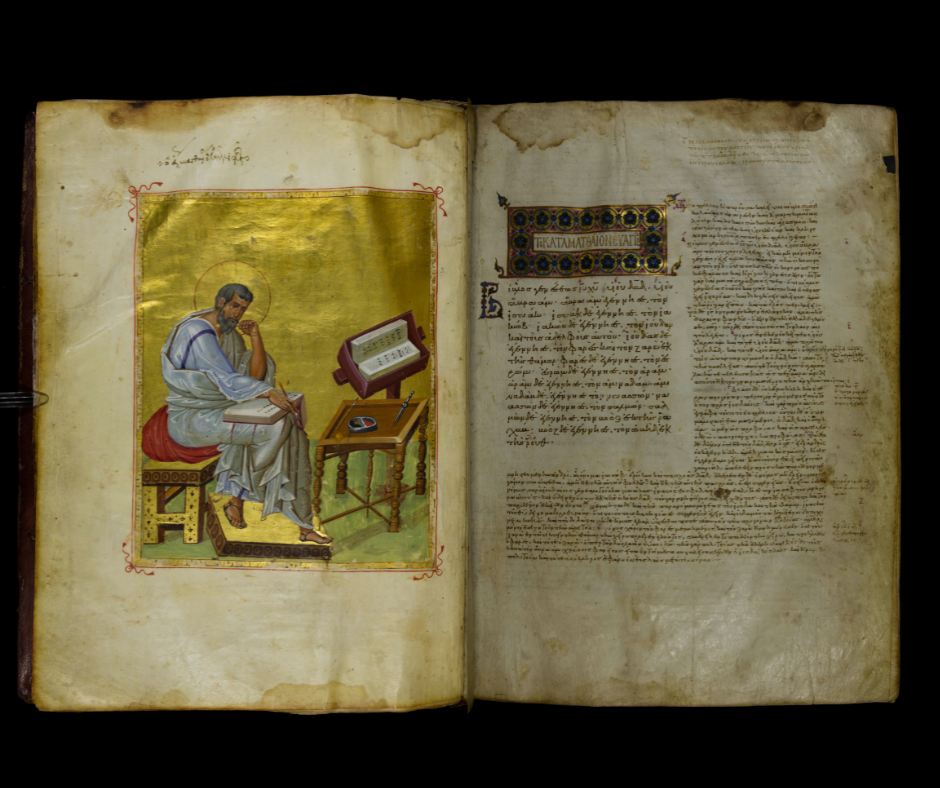By: Andrew J. Patton
Editor’s note: This post goes into more detail about one aspect of catena manuscripts. For a more general introduction to Greek New Testament catena manuscripts, see the previous Manuscripts 101 blog on Greek New Testament catena manuscripts.
Greek New Testament catena manuscripts contain two primary texts: the Greek New Testament and the catena. Scribes deployed a variety of techniques to format these two interconnected works in the same manuscript. The layout of catena manuscripts usually appears in one of two formats: frame or alternating. This Manuscripts 101 blog will explore these two layouts and how the relationship between text and comment works.
The Frame Catena Format
Frame catenae present the biblical text in the center of the page and fill the outer margins, and sometimes the inner margin with commentary, as seen in GA 773 (Figure 1).
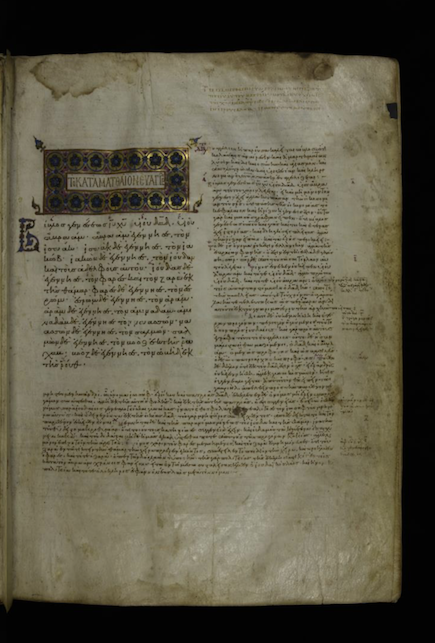
This layout clearly separates the two works on the page. Frame catenae link the exegetical extracts to the biblical text using numbers, symbols, or short excerpts of the biblical text or a combination of these.

In Figure 2, GA 773 uses both numbers (in the form of Greek letters) and symbols to link the text and commentary. The scribe placed the sign in the biblical text, before each comment, and in the outer margin to help readers navigate between the Scripture and scholia.

The catenist created a verbal link between the Scripture and catena in the comment on Luke 1:1. Figure 3 shows how the extract begins with a short lemma comprising the first five words of Luke 1:1 in the commentary (ἐπειδήπερ πολλοὶ ἐπεχείρησαν ἀνατάξασθαι διήγησιν), followed by a middle dot to mark the end of the reference, before beginning the exegesis of that text. The scribe also employs the numerical system, marking it with a number in the text and commentary.
The Alternating Catena Format
Alternating catena manuscripts contain a single block of text with Scripture, then comment, followed by more Scripture. In this layout, scribes distinguish the biblical and catena texts in a variety of ways.
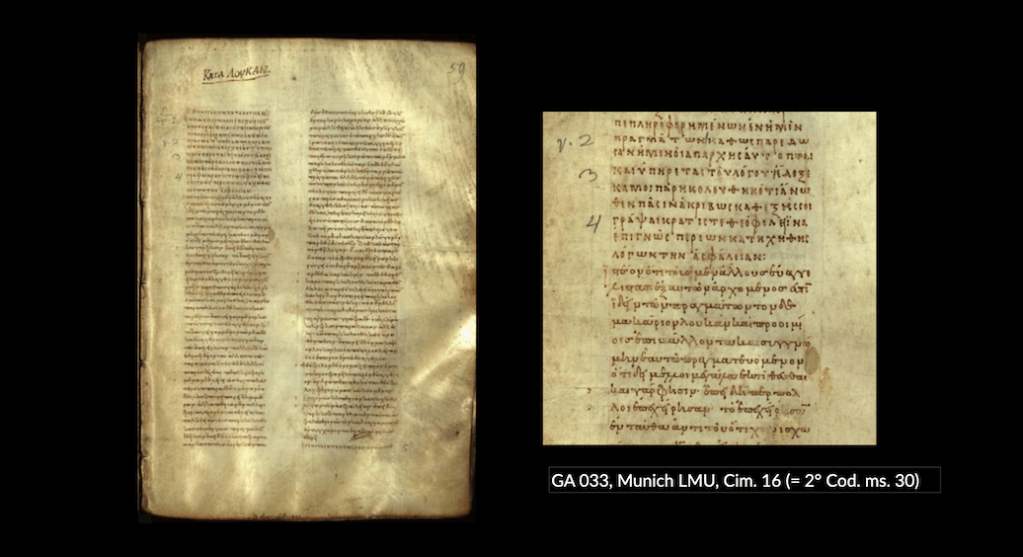

In GA 033 (Figure 4), the script changes from majuscule for the biblical text to minuscule for the commentary and a line break separates the biblical text and commentary sections. (You can read more about the handwriting types in Greek New Testament manuscripts in this Manuscripts 101 blog by Clark Bates.) In GA 807 (Figure 5), the two texts are differentiated by color with the biblical text copied in red and the commentary in black. In both cases, the copyists wrote longer biblical lemmas before the commentary sections. At the beginning of Luke, the first section of Scripture gives Luke 1:1–4 followed by a long block of commentary, which other manuscripts divide into eight separate comments. Then the second section of Scripture reads Luke 1:5–17, followed by more commentary.

GA 1411 tries to make the texts separate by changing the script—quite inconsistently—with a semi-majuscule script (Figure 6, blue rectangle) for the lemma and minuscule for the catena text (Figure 6, green rectangle). Yet the same semi-majuscule script is also sometimes used to signal the start of a new scholium without any biblical text. The somewhat haphazard production of this manuscript makes it more difficult to distinguish the biblical text from the commentary text.
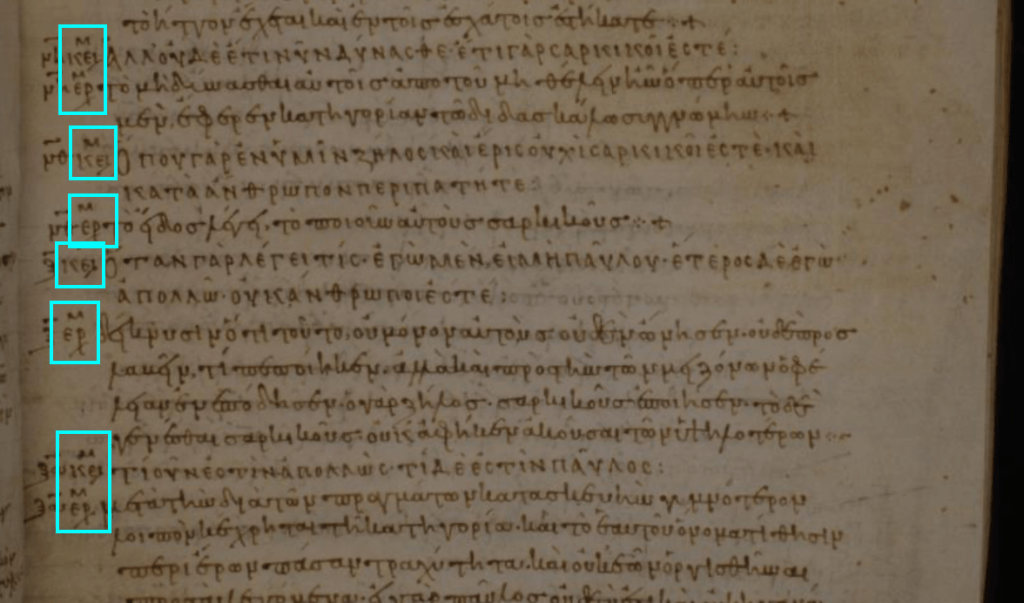
GA 0150 (Figure 7) signals the biblical text and interpretation with labels. The Scripture is labeled in the margin with κεί(μενον) meaning the text or phrases, and the scholium is labeled with an abbreviated ἐρμ(ηνεία) meaning interpretation. Along with these labels, the two texts are differentiated by numbers, script changes, and line breaks. These techniques make it easy to distinguish between the biblical text and the catena text in this manuscript.
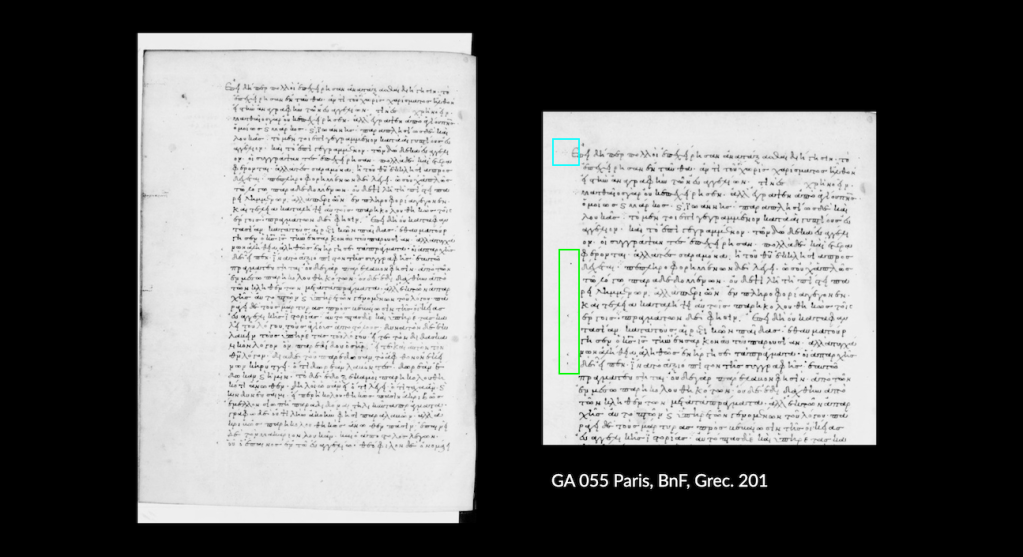
At the other end of the spectrum, GA 055 (Figure 8) has no consistent pattern for distinguishing biblical text and commentary in Matthew, Luke, and John. It uses something like a division symbol (÷) to mark biblical lemmas and divisions within the scholia (Figure 8, blue rectangle). These are faint in these microfilm images, probably because they were copied in red ink. Marginal carat marks (Figure 8, green rectangle) also indicate biblical text.
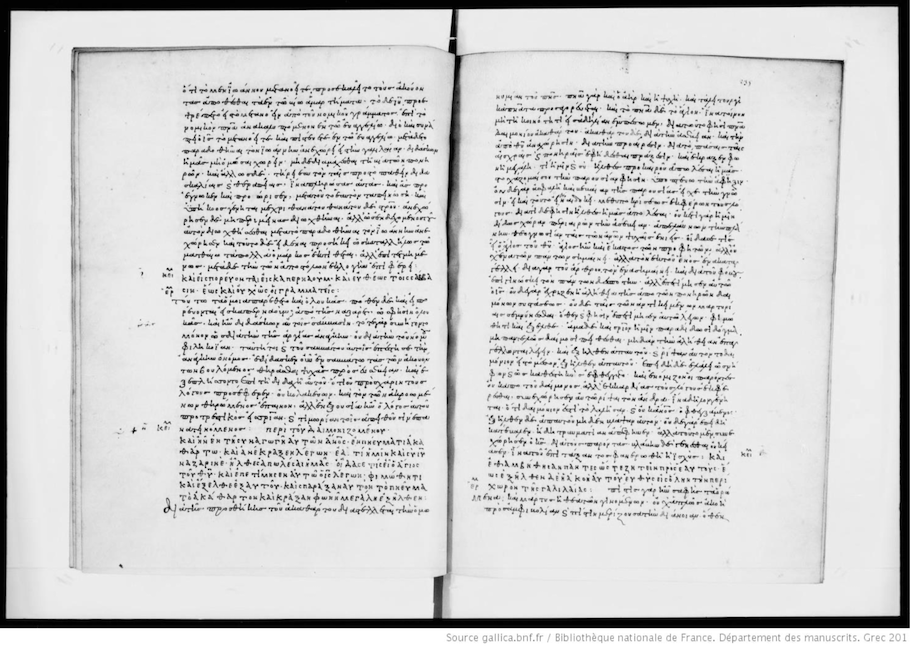
In Mark, the scribe changed formats and copied the biblical text in majuscule script, frequently used line breaks, and added the κείμενον and ἐρμηνεία labels. It is worth noting that GA 055 does not have the complete biblical text in any book but was assigned a Gregory-Aland number in an earlier period of cataloguing New Testament manuscripts. This may explain why less differentiation was used in this codex compared to many of the other examples of Greek New Testament catena manuscripts featuring an alternating layout.
Conclusion
Greek New Testament manuscripts with a catena include two extensive texts which are closely related. Scribes copied these two works in two primary formats and deployed a variety of techniques to differentiate or link the Scripture and the scholia. The layout of the manuscript often has a bearing on the biblical text in it. According to the data in Georgi Parpulov’s catalogue of New Testament catena manuscripts, frame catenae nearly always include the full biblical text; he only identifies two frame catenae with an abridged biblical text.
Alternating catenae, however, may or may not abridge the biblical text. Some manuscripts like GA 055 and GA 1411 only include selected portions of the Gospels which were necessary to understand the comments, whereas GA 033, GA 0150, and GA 807 include the full biblical text. Analyzing the layout of catena manuscripts and their biblical text may offer interesting ways to study these codices for New Testament textual criticism, and the linking techniques may lend us more information about how people read or studied the Scriptures in Byzantium.
Andrew J. Patton is a PhD candidate studying Greek catena manuscripts on the Gospels through the CATENA Project at ITSEE in the University of Birmingham. He has published on catena manuscripts with the so-called ‘Western’ order of the gospels, collaborated on a catalogue of the Greek manuscripts in Birmingham, and is a co-editor and contributor to That Nothing May Be Lost: Fragments and the New Testament Text. Prior to studying at Birmingham, he worked for CSNTM as the Development Manager and on digitization expeditions.

